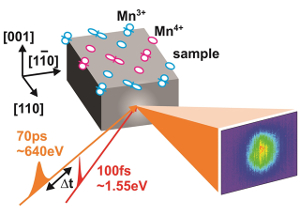Staged change found in shifting material
 Researchers have discovered some interesting ways to influence a material that could be central to all electronics in the future.
Researchers have discovered some interesting ways to influence a material that could be central to all electronics in the future.
Manganites – compounds of manganese oxides - show great promise as materials for future electronics because of their ability to instantly switch from an electrical insulator to conductor under a wide variety of external stimuli.
The change can be made by using magnetic fields, light, x-rays and vibrations – several ways to cause electrons and electron-spins in a manganite to organise and re-organise in response to such stimuli.
In a recent study of such materials, researchers at the Berkeley Lab in the US found that they react in distinctly different ways, depending on what they have been exposed to.
The team was looking at the properties of praseodymium calcium manganite (PCMO) crystals, a model manganite system, when they discovered that under photo-stimulation the insulator/conductor switching, which depends primarily on charge-ordering, may be ultra-fast, but the re-ordering of electron-spin, upon which magnetic properties depend, is not.
The change in charge is much faster than the change in spin.
In fact, the re-ordering of spin in these materials actually exhibits a glass-like state, in which the restoration of crystalline order is substantially delayed.
“The electron-spins get trapped in a frustrated, disordered state, like cars trying to merge without road signs or lane markers, and can take multiple seconds, a comparatively very long time, to sort themselves out,” says Robert Schoenlein of Berkeley Lab's Materials Sciences Division, one of the leaders of the study.
“This separation of charge-ordering behaviour from spin-ordering behaviour may point the way to new approaches to manipulating spin effects for applications in switching and memory devices.”
“We found that the glass-like behaviour of the electron-spins arise from the metastable state created by photo-excitation, a state characterized by spin disordered metallic droplets within the larger charge- and spin-ordered insulating domains,” says ALS staff scientist Chuang.
“Comparison with time-resolved resistivity measurements suggests that the collapse of spin ordering is correlated with the insulator-to-metal transition, but the recovery of the insulating phase does not depend on the re-establishment of the spin ordering.”
Adds Zhou; “Our work provides a new perspective for revealing the fascinating physics hidden in the recovery dynamics of electronic ordering in correlated electron materials after transient photo-excitation, a prominent method for ultrafast manipulation of material properties. Since other transition metal oxides that exhibit intriguing emergent phenomena, such as the high-temperature superconducting cuprates, also have rich competing phases involving dynamic electronic orderings, we should be able to extend similar TR-RSXS studies to those systems as well.”
The full report has been published in the journal Scientific Reports, entitled “Glass-like recovery of antiferromagnetic spin ordering in a photo-excited manganite Pr0.7Ca0.3MnO3.”








 Print
Print